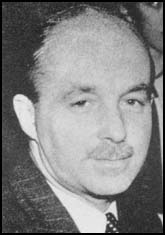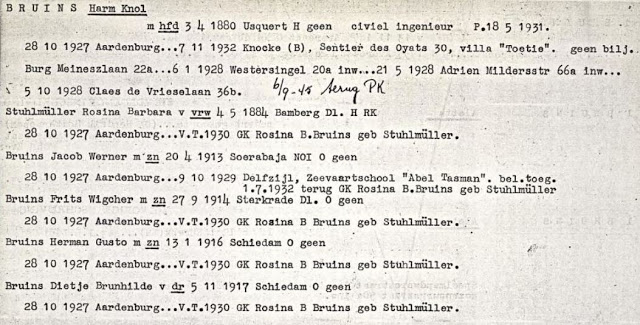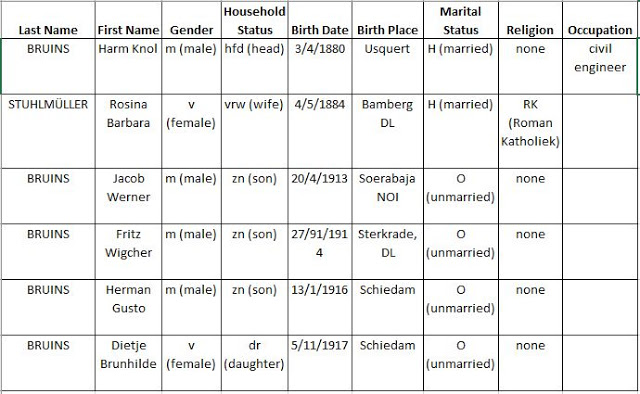N.B. I have written a follow-up post about Bruin which can be accessed here.
During research for a few recent blog posts, I’ve been reviewing Guy Liddell’s diaries, the original documents from The National Archives at Kew. In that process, I’ve come across a few interesting tidbits that warranted further investigation, if only to satisfy my own curiosity.
Liddell’s Diary

Head of MI5’s B Division
during the Second World War
One of those tidbits was Liddell’s reference to H.K. Bruins on 21 August 1940. The diary entry reads:
August 21, 1940: […] A German named H. K. BRUINS who came over here in the guise of a refugee from Belgium and Holland, is a self-confessed German agent. He had been in possession of a wireless set with which he had been communicating weather reports and other information to the Germans. He had also been instructed to give them early intimation of the advance of British troops into Belgium. This I gather he had done. He was working for RANTZOW [sic]. The question now arises whether this is a shooting case. There is no doubt what ever [sic] that BRUINS [sic] was a German agent and very little doubt that he was operating against us. He was certainly operating against our allies.
There are several items of interest in this entry:
- It sounds like Bruins came to England with a wireless set as a supposed refugee but was actually a German agent. As far as I know, the first wave of agents with wireless sets were the four spies who landed along the coast of Kent in early September 1940. Followed closely by Wulf Schmidt and Gösta Caroli in mid-September. But Liddell’s entry makes it sound like Bruins was an earlier spy who arrived in August 1940. This would be news indeed. But it also sounds like Bruins was working on the continent, reporting on the movement of British troops. Did Bruins then take his wireless set to England and use it there?
- According to Liddell, Bruins was working for Rantzow – likely a misspelling of Rantzau a.k.a. Nikolaus Ritter, head of the I Luft section of the Hamburg Abwehr. Was Bruins part of Operation LENA run by Nikolaus Ritter?
- Liddell indicates that there is “very little doubt” that Bruins was working against the British and that the only question “is whether Bruin [sic] is a shooting case”. Based on what happened to the other German spies, one would think that Bruins’ case would have been open and shut. He was caught with a wireless set and confessed to being an agent of the Germans – clearly a first-class candidate for prosecution. There is, however, no evidence that Bruins was executed, nor even prosecuted, which leaves us wondering… what became of Bruins?
The most obvious place to look for information on H.K. Bruins is the National Archives. Unfortunately, I have been unable to uncover any Security Service file on this agent. Other sources, however, have yielded enough information to begin to answer the above questions.
Camp 020
I had a look at the Camp 020 book published by the PRO in 2000 (edited by Oliver Hoare). There is no mention of Bruins in the index, which is a bit perplexing if he was considered a “shooting case”.
Luckily, there are some other Camp 020 files at the National Archives that can shed some light on Bruins. File KV 2/2593, which records a list of case in Camp 020, has an entry for Harm Knol Bruins which indicates that he arrived at Camp 020 on 10 August 1940 and was transferred to Camp 001 (Oratory Schools) on 19 September 1940. A handwritten comment notes that he was deported to “Holland” in 1945. His personal file (PF) number was 54330 and a note states that the file was destroyed on 7 October 1960. That may explain why there is no file on Bruins in the National Archives.
The short amount of time Bruins spent at Camp 020 (about a month) suggests that he was not considered a “shooting case”. Which leaves one wondering, how could a German agent equipped with a wireless set simply be detained for the duration of the war when others were executed for the same crime?
Dutch Resources
The fact that Bruins was deported to the Netherlands suggests that he might have been a Dutchman and several Dutch-language references do, indeed, mention Harm Knol Bruins. I have used Google Translate on the original Dutch and present here only the English translations. Readers are invited to use the web links to access the Dutch versions. The first reference I came across simply stated:
Doctor Hamkes – active for Nest Cologne, knew in October 1938 the Dutchman H.K. Bruins recruited for sending weather forecast for Nest Cologne (From Intelligence Service Rotterdam site)
Further references to Hamkes and Bruins are contained within a series of online documents (De Abwehr in Nederland (1936-1945)) from NISA (Netherlands Intelligence Studies Association). The documents are from an unfinished 2006 manuscript by Frans Kluiters which was edited after Kluiters’ death (2009) by Etienne Verhoeyen (2016). Verhoeyen published a book in 2011 about the German Abwehr’s activities in Belgium, which also provided some useful information.

It would appear that Hamkes (or Doktor Hamkes/Hamken) was the code name of Major Walter Schulze-Bernett, an officer of the German Abwehr.
Walter Emil Gustav Schulze was born 27 November 1896 in Hamburg, the son of a German theatre painter (Friedrich Conrad Gustav Schulze) and an English mother (Amalia Alwina Hamkens). A marginal note on Walter’s birth registration states that: On 8 February 1939, Walter changed his family name from Schulze to Schulze-Bernett. It would appear that Schulze-Bernett used a slight variation of his mother’s maiden name (Hamkens) as his Abwehr code-name (Hamkes/Hamken).
Schulze-Bernett served in the First World War and was awarded the Iron Cross (First and Second Class). After the war, he worked for the police for several years, before becoming involved in banking. From 1920 to 1935, he worked for several banking interests in Amsterdam.
In 1935, Schulze-Bernett went to Berlin and was assigned to Abwehr Ast I in Nest Cologne. According to Schulze-Bernett, during the period from 1935-1938, his agents didn’t have any “real” missions but were simply given practice tasks such as discovering the location of French army units (data that could be checked against a French publication which the Germans had acquired).
In September 1938, Schulze-Bernett was attached to the German embassy in The Hague as an attaché. He was instructed to expand his espionage networks in Belgium, France and England. After the declaration of war in 1939, Schulze-Bernett’s assignment was expanded to include the Netherlands.
At some point, in the fall of 1938, Schulze-Bernett became acquainted with Dutch civil engineer, Harm Knol Bruins in Rotterdam who was eventually recruited as an agent. Since Schulze-Bernett had been transferred to The Hague around the same time that Bruins was recruited, the new agent was likely transferred to another spy handler at Nest Cologne (one source suggests this was Major Friedrich Rudolph, head of I Heer).
Civil Engineer & Spy – Harm Knol Bruins
Harm Knol Bruins was born 3 April 1880 in Usquert (Gröningen) to Jacob Bruins (24 year old farmer) and his wife Dietje Huizinga. On 12 June 1912, Bruins married Rosina Barbara Stuhlmüeller (born 4 May 1884 in Bamberg, Germany) in Usquert. He gave his occupation as a postal engineer.
A family card from the Rotterdam population registers provides us with some information about Bruins and his wife. It’s taken a bit of deciphering but the information contained on the family card seems to follow this pattern:
- Last Name
- First Name(s)
- gender – m (male) or v (female)
- relation to head of household – hfd (head), vrw (spouse), zn (son) dr (daughter)
- birth date
- birth location
- marital status – H (married), O (unmarried)
- Religion – geen (none), RK (Roman Katholiek)
- occupation
As for some of the other abbreviations: inw=inwonend=live-in; GK=Gezinskaarten=Family Card; VT=Volkstelling=Census; PK=Persoonskaarte=Persons Card.

I’ve done a quick transcription of the personal information (see image below):

We can see that Bruins and his wife had at least four children:
- Jacob Werner Bruins – born 20 April 1913 in Soerabaja NOI (Nederlands Oost Indië) (now Surabaya, Indonesia)
- Frits Wigcher Bruins – born 27 September 1914 in Sterkrade, Germany (Ruhr Valley northwest of Essen) – died 25 March 2012
- Herman Gusto Bruins – born 13 January 1916 in Schiedam (outskirts of Rotterdam)
- Dietje Brunhilde Bruins – born 5 November 1917 in Schiedam (outskirts of Rotterdam) – died 1 October 2013
The fact that Bruins’ eldest son was born in the Dutch East Indies suggests that Bruins and his wife may have travelled there during the course of his work as an engineer. [N.B. 2024 09 21 – Researcher Ivar B. has learned a bit more about Bruins’s time in East. Apparently Bruins applied for work with the Telegraph and Telephone section of the Colonial Department of the Dutch Government. He went over to the Dutch East Indies, but once again could not get along with his superior (his words). He was fired and returned to the Netherlands after just over a year.] It would appear, however, to have been a short trip as the couple were back in the Europe by 1914. Bruins would have been 34 years old at the outbreak of the First World War, but I have come across no military records to indicate that he served with the Dutch Armed Forces. Bruins’ movements in the late 1920s/early 1930s can be roughly traced using his residences on the family card:
- 28 Oct 1927 – Aardenburg (town in the southwest corner of Netherlands near Belgian border)
- 6 January 1928 – Westersingel 20a (Rotterdam) – live-in
- 21 May 1928 Adrien Mildersstr 66a (Rotterdam) – live-in
- 5 October 1928 Claes de Vrieselaan 36b (Rotterdam)
- 7 Nov 1932 – Knocke (Belgium) – likely Knokke-Heist, Belgium. The address “Sentier des Oyats 30, villa Toetie” is perplexing and essentially means Path of Oyats (beach grass). It is possible that the address was a beach cottage. N.B. 2020 12 08 – I received an email from a reader, Ivar B., who said that the address is now Helmweg and that the original villa (Villa Toetie) no longer exists.
N.B. 2020 12 08 – Ivar noted that Bruins first terms up in Belgian records on 25 April 1933 when he was registered as living in Knokke with Anna Lilian von Vaupel-Klein. She was Dutch, born 4 March 1909 in the Dutch East Indies (Sumatra). This would obviously explain what transpired the following year between Bruins and his wife.
On 6 July 1934, according to a marginal note on Bruins’ marriage certificate, he and his wife were divorced in Brugge, Belgium. [N.B. 2020 12 08 – Two years later, on 17 October 1936, Bruins and von Vaupel-Klein were married in Knokke, Belgium.]
It would then appear that in late 1938, Bruins was recruited as an agent of the German Abwehr. From May 1939 to December 1939, Bruins travelled to Cologne every month to receive training in Morse code and military matters from two Abwehr officers, Roemer and Koch (likely cover names). Bruins received two cover addresses in Cologne to which he was to send information about airports and aircraft factories in Belgium. He was also instructed to send weather reports (air pressure, temperature, cloud cover, wind direction, precipitation). In order to complete his mission, Bruins was given a wireless transmitter with which he sent messages twice a day in code.
At the end of March 1940, Bruins moved from Knokke (a Belgian coastal community just across the border from the Netherlands) to de Panne (a Belgian coastal community on the border with France, just east of Dunkirk). N.B. 2020 12 08 – Ivar also had an address for Bruins – Koninginnelaan 15. He also indicates that Bruins brought his second wife, von Vaupel-Klein with him.
According to the NISA documents, Bruins required a replacement part for his wireless transmitter which was to be delivered by a “Sturm” (officer/courier/agent?) of Nest Cologne. The courier was stopped en-route, however, and questioned by the authorities at which point he revealed information about Bruins. Strangely, Bruins and his wife (Anna Lilian von Vaupel-Klein) were only arrested on 12 May (two months later) by the French Sûreté and his wireless set was confiscated. According to Kluiters, the rapidly advancing German armies meant that there was no opportunity to try Bruins and he was transferred to Camp 020 in England on 10 August 1940. He spent just over a month at Camp 020 before being sent onwards to Camp 001 and interned for the duration of the war. According to one source, Bruins was interned on the Isle of Man where he made extensive statements which showed that he was indeed a German agent.
From the Camp 020 records, we know that Bruins was deported back to the Netherlands in 1945. A hand-written note on the Rotterdam municipal census records (see image above) may give an exact date for his return: 6/9 – 45 terug [back?] PK. The PK likely stands for a Persoonskaart – and that would support that this may be the date (6 September 1945) upon which he returned to the Netherlands and was assigned a new Persoonskaart.
N.B. 2020 12 08 – Bruins was fortunate to have escaped with his life. His second wife, Anna Lilian would not be so fortunate. Ivar shared that Anna was the aunt of his father-in-law. Anna was executed on 27 May 1940 by the French in Bailleul, France. That seems a rather rapid sequence of events from arrest (12 May) to execution (27 May), a shade over two weeks. Mind you, this was shortly after the Blitzkrieg invasion of France and the Low Countries by the Germans. So perhaps such niceties as civil trials were abandoned in favour of summary court martials and executions. Although again, it doesn’t explain why Bruins lived and his wife died.
In 1949, four years after returning to the Netherlands, Bruins wrote to the “State Security” and said that while he had been interned under suspicion of espionage, the suspicion was unfounded. N.B. I found a Dutch archives site (related to the war graves foundation) which has a 1957 document in which Bruins was requesting the assistance of authorities in getting a death certificate for his wife. This seems to have been for the purpose of claiming her inheritance/estate.
An appendix in the NISA documents indicates that Bruins passed away on 13 January 1966. N.B. Bruins is buried at Westduin Cemetery on the western outskirts of The Hague (grave number A1/9/116/-).
According to Liddell, Bruins was an agent of Rantzau but Etienne Verhoeyen doubts that this was the case. First, Bruins never mentioned that he was recruited by Ast Hamburg. Second, according to the leader of the Kriegs-Organisation Belgium, Fritz Unterberg, Bruins was sent to the Belgian coast with a transceiver by Major Wolfermann, the radio specialist from Ast Münster (umbrella organization for Nest Cologne). The radio connection was apparently maintained by Brandel, an operative of Nest Cologne. (To support this information, Verhoeyen quotes: NARA, RG 226, E 119A, B 34, F894, Compte-rendu de l’interrogatoire de F. Unterberg door de Securite Nationale Parijs, 4.8.1945.)
Conclusion
What then can we deduce from all of this? Can we answer the questions posited above? Some of them, most definitely.
It would appear that civil engineer Harm Knol Bruins was recruited in The Netherlands in late 1938 or early 1939 by Major Walter Schulze-Bernett (code name Doctor Hamkes/Hamken). Bruins received training at Nest Cologne in wireless transmission and was sent to coastal Belgium to report on military matters (airports and aircraft factories) and the weather. On 12 May 1940, Bruins and his wife, von Vaupel-Klein, were arrested by the French authorities but, due to the rapid advance of the German army, Bruins was not prosecuted on the Continent but sent to England.
Bruins arrived at Camp 020 on 10 August 1940, which leaves one wondering, where was he for the three months between mid-May and mid-August. In the rush to evacuate the continent in late May 1940, had he become mixed in with other legitimate refugees? Although Liddell seemed to think that Bruins had the potential to be a “shooting case”, it would seem that there wasn’t enough evidence to prosecute the man. On 19 September, Bruins was sent to Camp 001 (Oratory Schools) and interned for the duration of the war. What became of his wife/girlfriend remains unknown. It would seem pretty clear that Bruins did not conduct any espionage with a wireless transmitter whilst in England and it is highly unlikely that he was a LENA agent sent by Nikolaus Ritter. Bruins’ second wife, von Vaupel-Klein was not so fortunate and was executed by the French. N.B. 2020 12 08 – Ivar has applied for access to some documents from a special judiciary council which might shed some more light on why Bruins was shipped to England while von Vaupel-Klein was executed by the French.
Post Script – Walter Schulze-Bernett

The story of Major Walter Schulze-Bernett, who recruited Bruins, is fascinating in its own right.
After the war (1973), Schulze-Bernett wrote an account of the Venlo Incident which took place in November 1939 shortly after Schulze-Bernett had been appointed as attaché with the German Embassy in The Hague.
From June 1940 to June 1941, Schulze-Bernett was head of Gruppe I, Ast Netherlands in The Hague. He worked closely with the head of Referat I Luft in The Hague, Major Mercker (alias Malten), who is likely identical with Major Merkel (alias Malten) with whom Josef Jakobs dealt whilst receiving training in The Hague. But that is another blog post!
In July 1941, Schulze-Bernett was appointed head of the K.O. (Kriegs-Organisation) Near East in Ankara, where he remained until 1 March 1943. He finished the war as a Lieutenant-Colonel. After the war, Schulze-Bernett was apparently interned by the Allies for a year, but then released. He lived in Hamburg with his wife and operated an import/export business, passing away in 1985.
Prior to his transfer to Ankara, it would appear that Schulze-Bernett was also involved with Operation Aquilar, a plan to save Jews by ostensibly by infiltrating Abwehr agents into a stream of Jewish refugees sent to the Americas. As part of this operation, Schulze-Bernett was able to save at least 176 Jews (and perhaps as many as 700). According to Tom Topol (Passport-Collector site), in 2015, Schulze-Bernett was nominated to be awarded the title “Righteous among the Nations”, although his name has yet to be added to the database on the Yad Vashem site.
I was unable to find any reference to Walter Schulze-Bernett in the National Archives catalogue at Kew, which is odd if he was involved with the Abwehr in both The Hague and Ankara.
Sources
NISA Intelligence – scroll down til the De Abwehr in Nederland section
Etienne Verhoeyen – Spionnen aan de achterdeur: de Duitse Abwehr in Belgie 1936-1945 – 2011 (accessed via Google Books)
Passport-Collector – has passports of Walter Schulze-Bernett and his family
Guy Liddell diaries – National Archives, Kew.
Genealogical sources – birth, marriage, census, population registers
Abendblatt – Operation Aquilar
Venlo Incident – piece written by Walter Schulze-Bernett
Dutch Abbreviations used in Population Registers (very helpful!)
Dutch Archives site – has a document from 1957 in which Bruins seeks a death certificate for his wife
Post Script – 2018 12 30
Author David Tremain kindly pointed out that in his book on J.M. Dronkers (Rough Justice – published 2016) he too has mulled on the identity of Abwehr spy handler Hamkus/Hamkens (see p. 39-42, 69, 81).
Post Script – 2020 12 08
Ivar B., nephew-in-law of Anna Lilian von Vaupel-Klein sent me an email in which he shared some more information about Bruins and his second wife. Thanks!

Pingback: Gezinskaart van Jacob Bruins (1856-1921) – Greets genealogie